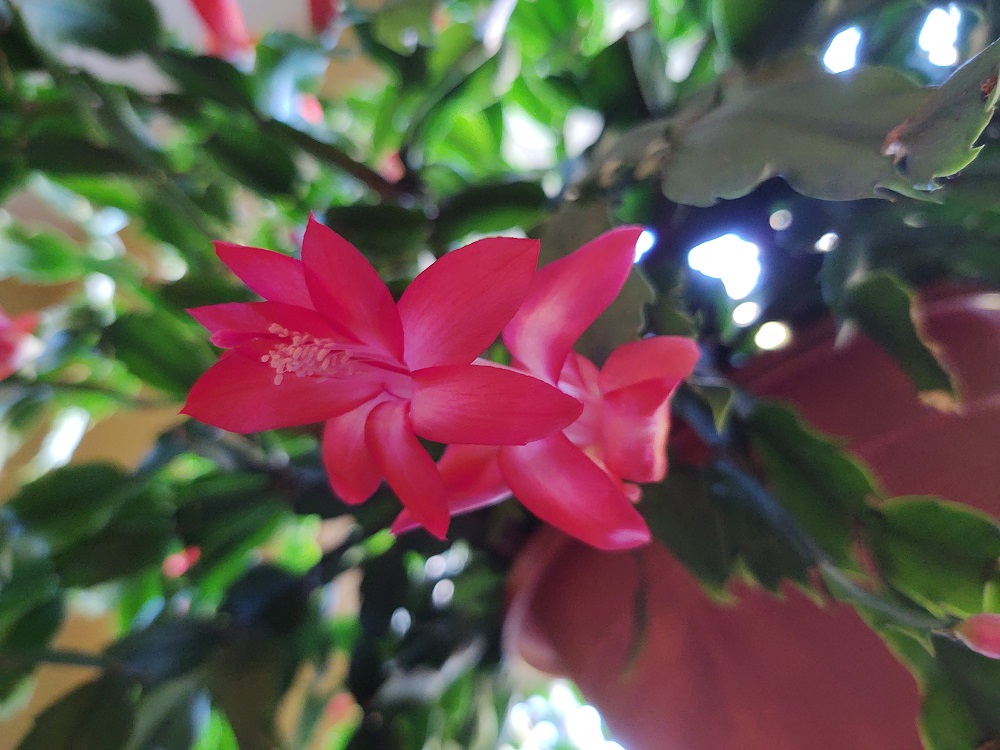
UT Gardens’ December 2020 Plant of the Month
Submitted by Mary Lewnes Albrecht, professor emerita, Department of Plant Sciences
The popular Christmas cactus is native to South American tropical rain forests and is quite different from desert cacti. Christmas cacti (and related Thanksgiving and Easter cacti) grow in rock crevices and on tree trunks and branches. Leaf litter and other organic matter accumulate in these spaces providing the growing media. This environment also has filtered sunlight and high humidity.
All these cacti are related and named for Belgian horticulturist, Frederick Schlumberger. Thanksgiving cactus (Schlumbergera truncata), Christmas cactus (Schlumbergera bridgesii, synonym Schlumbergera x buckleyi), and Easter cactus (Schlumbergera gaertneri, synonym Rhipsalidopsis gaertneri) and hybrids of these species are collectively called Holiday Cactus. Flower colors include red, pink, purple, orange and cream. The stems are segmented, flattened to round in cross-section, and feature weak or no spines. The stems gracefully arch making them excellent for hanging baskets.
An easy way to distinguish among the three species is the shape of the segments or cladophylls (translated to “flattened stems”). Thanksgiving cactus has the sharpest teeth or claws along the edges with the Easter cactus having rounded edges. The Christmas cactus segments have smaller teeth but are not nearly so rounded. There are no true leaves on these plants. The pollen-bearing anthers on the Thanksgiving cactus are yellow, whereas the anthers on the Christmas cactus are purplish brown.
Christmas cactus thrives in a well-drained mix rich in organic material. Don’t use the sand-based mixes intended for desert cacti. Use a combination of a peat-based houseplant mix blended in equal parts with a bark-based orchid mix. Pine bark fines, or pine bark soil conditioner may also be used in lieu of the orchid mix. This will provide good water retention and great drainage at the same time. Make sure the pot has drainage hole(s), then water thoroughly allowing excess water to drain thoroughly, before returning the pot to its saucer or outer decorative container. During the active growing season of spring through summer, keep the mix evenly moist. To set flower buds in the fall, allow it to go quite dry between watering.
When new growth starts from the branch tips in late winter or early spring, fertilize through summer following the directions for rate and frequency given on the fertilizer package. Overfertilization can damage your Christmas cactus’ fine, scant root system.

Give your Christmas cactus bright but indirect or filtered light during summer. Keeping it on the north side of the house under the shade of trees works, as does a screened in porch. Too much direct light can damage the plant.
To encourage flower bud formation in late summer, slowly decrease the amount of water, letting the mix dry out between watering. Flower formation occurs under the shortening days and the cooler nights of autumn. If you keep the Christmas cactus outdoors, it can handle night temperatures down into the 40s. Don’t let it stay outdoors if night temperatures begin to dip below 40 degrees F. If it remains indoors year-round, find a space where gets cool (between 55 and 65 degrees F) and where it can be in total darkness for approximately 13 hours every night. The cooler the nights, the less dependence on the strict 13 hours of darkness. If the night temperatures are above 70 degrees F, 15 hours of darkness is recommended.
Flowers drop off Christmas cactus for many reasons: excessive flower set (too many buds), sudden changes in temperature (drafts from heating vents), amount of light, or moisture level in the growing mix (too dry or too wet). To reduce the chances of bud drop, make sure you water properly, especially during blooming. The numerous petals increase the surface area from which water will evaporate. If possible, do not move your Christmas cactus to another location when buds are present or flowers are open.
Don’t worry if the plant gets “too big for its pot.” They can remain in the same pot for several years and grow well when pot bound. And, when it is time to move into a larger pot, prune back the plant and repot into a slightly larger container (for example, go from a 6-inch to an 8-inch pot).
The major disease is root rot, which can be prevented by avoiding excessive watering. Potential insect problems include mealybugs, soft brown scale, red spider mites and aphids; however, these are uncommon.
The UT Gardens includes plant collections located in Knoxville, Crossville and Jackson. Designated as the official botanical garden for the State of Tennessee, the collections are part of the UT Institute of Agriculture. The Gardens’ mission is to foster appreciation, education and stewardship of plants through garden displays, educational programs and research trials. The Gardens are open during all seasons and free to the public. For more information, see the Gardens website: utia.tennessee.edu/state-botanical-garden.